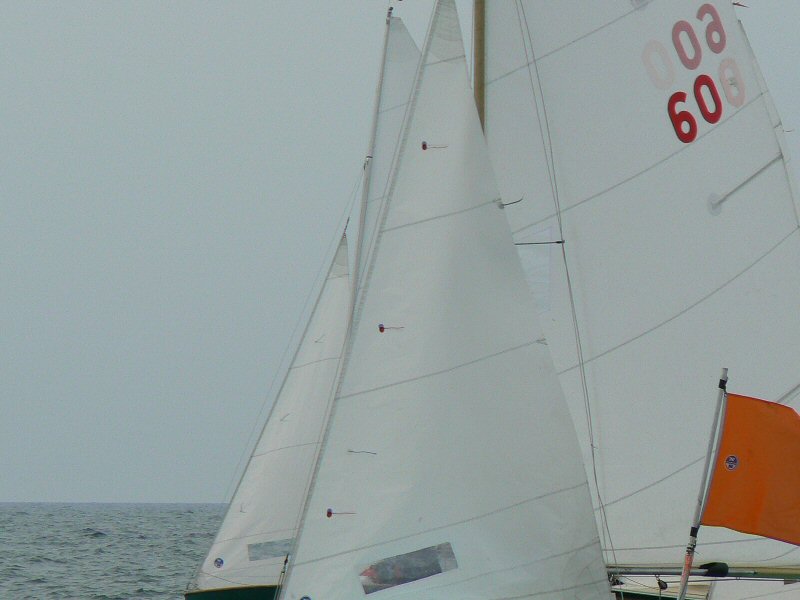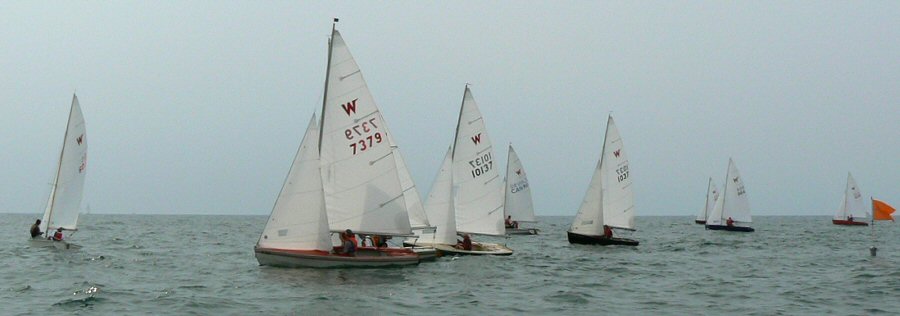|
Toronto Sailing & Canoe Club * August 19-20  Saturday: Race 2.1 photos by Gord Nikaido & Boris Kuzmin |
 |
| Getting ready for race 2: Grigor
makes sure the flag halyards will run smoothly. ... |
 |
| Ken Devlin (W8261) is set to
hoist the (4-minute) Prep signal with a snap! ... |
 |
|
About two seconds before the
start: A major back during the final two minutes of the countdown has
really favoured the pin end to the extent of making the line hard to
cross on starboard. Al (behind Tommy near the pin end) is about to put
the helm down and tack to port. Once Al has started his tack, Alastair,
half a boatlength off
Al's transom, won't be permitted to make any course change that
prevents Al from keeping clear (rule
16) - not even to luff up to cross the line. The start gun went as Al
was tacking, and Alastair grumbled but
did not protest. It was indeed a win-win situation since Al's tack got
Al what he wanted but also left Alastair in clear air as Al's tack
removed a
source of backwind that would - given Al's ability to pinch - have
buried Alastair at this crucial juncture of the race.
... |
 |
|
It was hard but not impossible
to cross the line on starboard: Tommy (60) once more gets the start - or does he??!! The real key to this start was that the
late shift had made it
possible
to
virtually lay the windward mark in one tack on port, and the #1
priority now was to get onto port tack as fast as possible since any
time spent on starboard might well end up being wasted time. Above, you
can
see the bow of Al's SHADES
already tacked to port.
... |
 |
| While others struggle in the
pin-end mess ... ... |
 |
|
... Al and Marc (3854) are off
on port, laying the mark, while even those with the best pin-end starts
are now trapped on starboard by others on starboard astern and to
windward. We could, of course, have settled for a start near the
unfavoured RC boat end and tacked without undue stress or excitement
but look where that approach has left Hans (938)!! This is where the
race was won: Marc and I ultimately fell about 50 yards short of laying
the mark, but most of the others leaders had to sail much more than
that on starboard before they finally managed to tack, and anything
more than that 50 yards was pretty much wasted distance.
... |
 |
| View from the RC boat: This set
of photos illustrates graphically what is meant by the advice "Keep
your eye on the big picture!" Less than half the fleet ... ... |
 |
| ... seems
to have realized (or care??!!) that we can (more or less) lay the mark
on port tack. ... |
 |
|
This shot illustrates boats
trapped on starboard tack: Kit (1037) will starboard Alastair (10137)
if the
latter tacks, so Alastair feels trapped on starboard. By continuing on
starboard, Alastair does the same to the boat to leeward of him, and
that boat is turn keeping Fred (7379) from tacking. Tommy (l) has benefitted from his great
start and tacked to port. He'll likely just nicely lay the mark, but
he's already on the lay line with nearly the whole beat to go - a
dangerous place to be!!
... |
 |
| It looks
like Alastair (l) and Fred
(7379) have gone too far left. This is a classic case of Avoid the lay line as long as possible!!! And
with the wind having skewed the course so badly, the port lay line is
virtually the line from the start mark to the windward mark. Which is
why Al and Marc were so desperately eager to tack right at the start! Unless Fred and Alastair get a better breeze of their own (or a known advantage like the George Blanchard shift - not applicable here, with the wind veered this far towards the south), only bad things are likely to happen to them out here on the lay line: 1. if there is a port lift for all boats, the boats to leeward and ahead will easily lay the mark and get there well ahead 2. if there is a port knock for all the boats, the boats to leeward and ahead will be able to tack and cross 3. if any of the boats slightly ahead decide for any reason to come out to where Alastair and Fred are, they will likely tack on Alastair's/Fred's wind and leave them to sail in dirt all the way to the mark or force them to throw in two more tacks and the wasted distance sailed between those tacks. ...
|